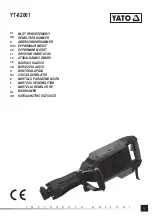
6
GB
Figure 4:
Place the extension lead over your shoulder and
work first on the large, flat surfaces such as the
bonnet, boot lid and roof, keeping your movements
as regular as possible.
Important! Allow the polishing machine to glide
over the polishing surface. Do not exert
pressure!
Figure 5:
Work next on the smaller surfaces (doors, for exam-
ple). Allow the mains cable to hang from the applian-
ce and hold the polishing machine as illustrated.
Figure 6:
For less accessible areas (such as wing-mirrors,
bumpers and door handles etc.), remove the
polishing cap from the pad and polish these areas by
hand.
Figure 7:
Now replace the textile polishing cap with the fine
polishing cap and pull this over the polishing pad.
Make sure it is completely clean. Remove the layer
of polish in the same order as it was applied.
Important! Do not exert pressure on the polishing
machine!
6. Disposal
The tool, accessories and packaging should be dis-
posed of in an environmentally-friendly fashion.
Plastic parts are coded for purposes of separation
when recycling.
7. Ordering replacement parts
Please quote the following data when ordering repla-
cement parts:
앬
Type of machine
앬
Article number of the machine
앬
Identification number of the machine
앬
Replacement part number of the part required
For our latest prices and information please go to
www.isc-gmbh.info
Anleitung BPM 500_SPK1 08.02.2006 17:55 Uhr Seite 6






































